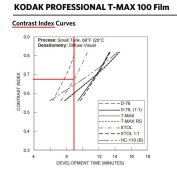- At last someone who prefers healthy negatives (versus wimpy negatives
)
- Certainly grain ("noise") increases with dev time. But so does the image contrast ("signal"). Not clear whether signal-to-noise is actually degraded.
I remember a thread where the OP was after intentional grain, and someone gave the advice to develop to low contrast and print on grade 5. Even easier with a s*****r because output range can be expanded almost arbitrarily.
lol... yeah, I like a “healthy” negative.
The appearance of grain is affected by both development time and contrast applied during post/print. If you use an appropriately matching tone curve, grain really isn’t so objectionable. If you under develop and jack the contrast way up (in post/print) it’s going to look grainy. If you over develop and jack the contrast way down, it won’t look as grainy. If you know what the characteristic curve looks like for a given time, you can use a matching tone curve to straighten it back out to gamma 1.0 and end up with grain that is present, but not particularly objectionable. This is assuming your density range is within what you can scan and still keep a lot of discrete tone values per stop of exposure. Once you go under a certain number of discrete tone values, no matter what you do, the grain starts to look chunky. Lots of people mistake it for grain aliasing, but it’s really just not having enough discrete tone values per stop of exposure.




